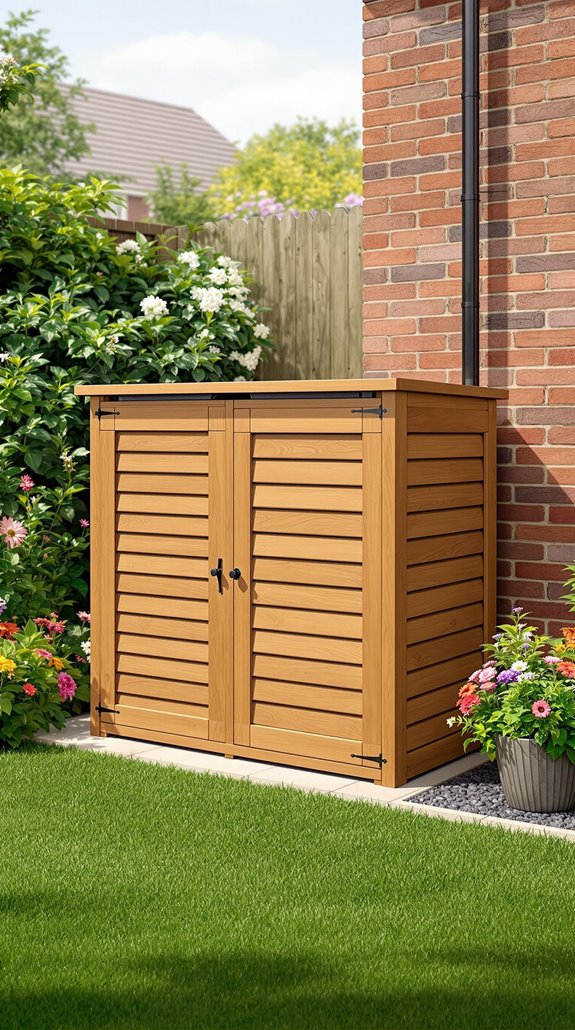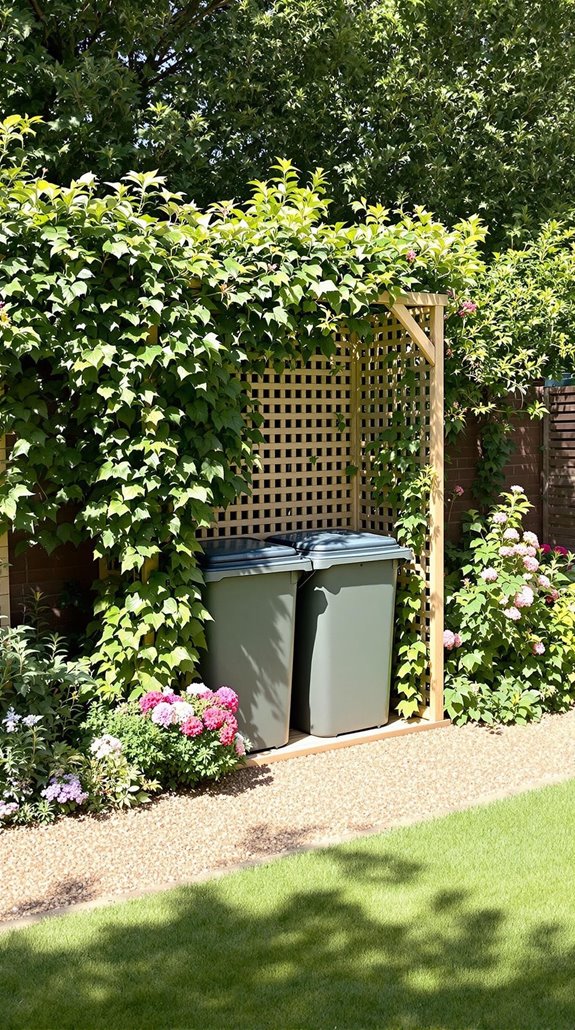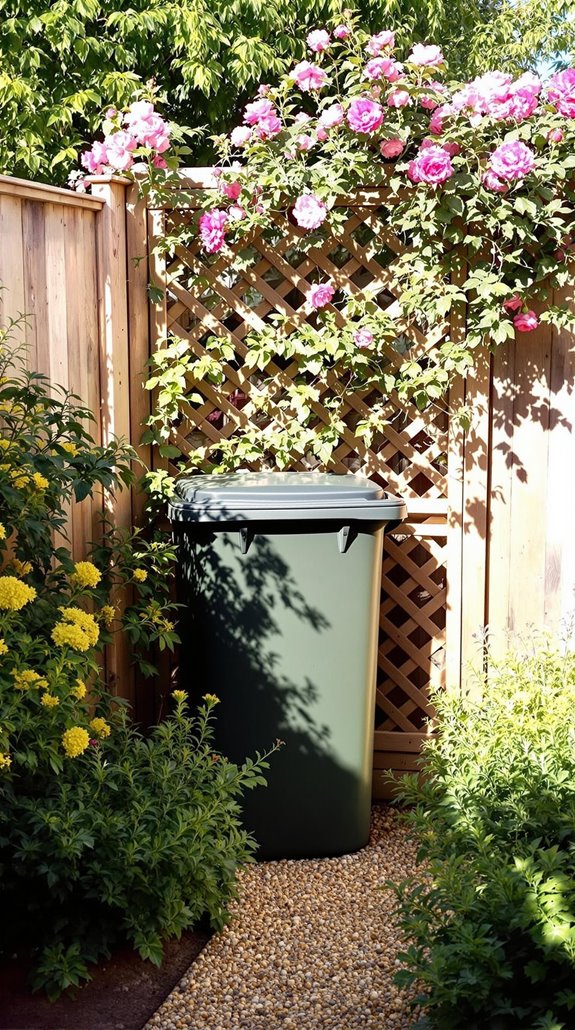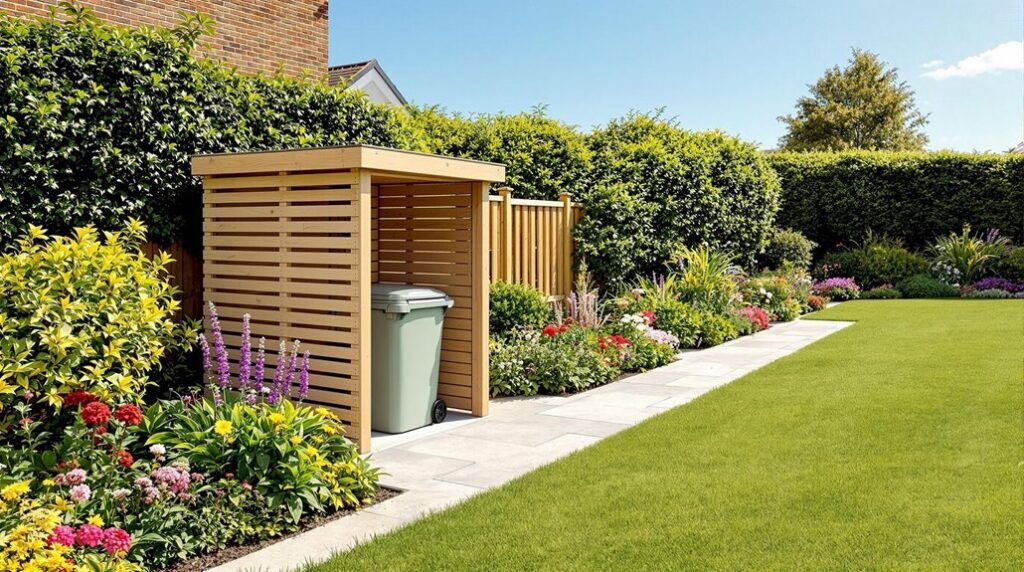I’ve discovered that strategically hiding wheelie bins transforms any UK garden from cluttered eyesore to polished outdoor space. Whether you’re dealing with limited space or simply want to maintain your garden’s aesthetic appeal, there are practical solutions that don’t require major renovations or hefty budgets. From clever structural modifications to natural camouflage techniques, I’ll show you eight proven methods that work with Britain’s unpredictable weather while keeping your bins easily accessible for collection day.
Key Takeaways
- Build custom storage units from pressure-treated timber like Canadian Western Red Cedar that integrate seamlessly with existing garden features and fencing.
- Create hidden storage by converting garden steps into concealed compartments using weather-resistant plywood and heavy-duty drawer runners for smooth operation.
- Install flexible screening solutions like woven willow panels or vinyl covers with artificial ivy for instant concealment without permanent construction.
- Use strategic plant-based concealment with fast-growing climbers on trellis systems or dense evergreen hedging like cherry laurel for year-round coverage.
- Combine multiple hiding methods by layering slatted fencing with tall perennials and storage units with integrated planters for enhanced concealment.
Transform Garden Steps Into Hidden Storage Areas
When you’re dealing with limited garden space, transforming your existing steps into hidden storage areas offers an ingenious solution that kills two birds with one stone. I’ll show you how to build drawers or cabinets directly into your step structure using weather-resistant plywood and metal brackets. You’ll need heavy-duty drawer runners to handle loaded bins smoothly. Design your facade with wood or stone cladding that matches your garden’s aesthetic – this creates seamless integration that fellow gardeners will admire. Don’t forget ventilation to prevent moisture buildup and odors. The key is maintaining your steps’ functionality while creating concealed storage that keeps your wheelie bins completely out of sight yet easily accessible.
Start by creating a cutting plan to minimize material waste when working with large plywood sheets for your step storage project.
Create Custom Built-In Storage Solutions
Rather than purchasing pre-made storage units that rarely fit your exact requirements, I’ll guide you through creating custom built-in solutions that maximize your available space while seamlessly integrating with your property’s design. Adding a garage extension can further enhance your home’s functionality and aesthetic appeal, making it a worthy investment.
I’ll help you repurpose existing structures like unused bike storage or garden sheds by reinforcing them with weather-resistant coatings and adapting dimensions for standard 240L bins. You’ll want to select 21mm pressure-treated Scandinavian Redwood with galvanized hardware for durability, building on solid bases to prevent rot.
For multi-functional appeal, I recommend combining bin storage with built-in seating or separate recycling compartments. Include 2cm air-flow gaps for ventilation, and choose chevron-clad doors with shiplap roofs for ideal weatherproofing while maintaining accessibility. These structures serve as an effective deterrent against pests like foxes, cats, and rats that commonly target exposed wheelie bins.
Install Weather-Resistant Wooden Bin Stores

While custom builds offer complete control over design specifications, pre-manufactured wooden bin stores provide proven durability with pressure-treated timber construction that’ll withstand harsh weather conditions for 10-12 years. I recommend Canadian Western Red Cedar or Douglas Fir options with heavy-duty 3×3 posts and featheredge cladding for maximum structural integrity. Additionally, budget-friendly materials can enhance your garden’s functionality without breaking the bank.
You’ll find configurations from single to five-bin units with customizable features like lift-up lids, chain systems, and ventilated designs that prevent odor buildup. The flat-pack assembly takes under 30 minutes without specialized tools, and freestanding designs eliminate complex groundwork. These units feature convenient handles that make accessing your bins effortless during weekly collections.
Choose from natural, brown, or grey finishes that complement your garden aesthetic. These PEFC/FSC-certified timber solutions blend seamlessly into landscapes while providing lockable security against unauthorized access.
Use Flexible Screens and Temporary Covers
Several flexible screening options deliver instant bin concealment without permanent installation commitments or complex construction projects. I recommend woven willow screens for their rustic charm and metal-reinforced durability, while vinyl covers with artificial ivy blend seamlessly into garden landscapes. Rattan-style panels offer sleek, low-profile designs in single to triple-bin capacities that suit compact spaces perfectly. These solutions accommodate standard UK 240L bins measuring 107cm × 58cm × 74cm, ensuring precise fitting. Architect fees can vary widely based on the complexity of the project, so it’s important to consider your budget when selecting a screening option. I particularly value the UV-resistant, waterproof materials that maintain appearance without ongoing maintenance. Most screens install tool-free with snap-lock panels or pre-cut adhesive applications, though metal-framed units benefit from two-person assembly.
You’ll appreciate the 30-50% cost savings compared to enclosed storage units, plus seasonal adaptability for changing garden aesthetics. The lockable doors on premium screen units provide essential security from wildlife and intruders while maintaining easy access for collection days.
Apply Creative Camouflage Techniques

Beyond conventional screening methods, strategic camouflage transforms wheelie bins into seamless garden elements through clever visual deception. I’ll show you how to make bins virtually disappear using creative techniques that work with your garden’s natural environment.
Consider adding a living roof to your bin storage structure – this introduces greenery that helps the storage blend into your garden setting. The vegetation creates natural camouflage while adding environmental benefits to your space, including energy-efficient improvements that enhance your garden’s overall appeal.
You can also replace a front wall with a storage cube, creating an integrated solution that doesn’t look like bin storage at all. I recommend utilizing spaces next to garden steps or other underused areas for this approach.
Use materials that match your house or garden walls for seamless integration. This guarantees your bins remain hidden without occupying additional garden space. Slatted fence panels can be customized to match your existing garden architecture while providing effective screening.
Design Strategic Plant-Based Concealment
Since plants naturally integrate into garden environments, they offer the most organic approach to wheelie bin concealment. I’ll show you two effective methods that create seamless bin hiding solutions.
For living willow screens, I insert whips 30-50cm apart and weave them together. This eco-friendly option requires minimal maintenance once established and provides year-round coverage with seasonal variations. Additionally, using recycled materials in your garden can further enhance the aesthetic while keeping costs low.
Alternatively, I install trellis systems with fast-growing climbers like honeysuckle or clematis. WPC trellis offers durability without maintenance, while diagonal patterns accommodate natural climbing habits. I choose evergreen varieties like ivy for consistent concealment.
Dense hedging using cherry laurel or yew creates an effective green barrier that blends naturally into existing garden landscapes. For ideal results, I layer multiple plant types to increase density. Full coverage typically takes 2-3 years, but the natural integration makes this worth the wait.
Maximize Existing Garden Structures

While creating new structures can be costly and time-consuming, I’ve found that maximizing existing garden features offers the most practical approach to wheelie bin concealment.
I recommend positioning storage units against fences or walls for structural support and space efficiency. You’ll want to choose materials that match your garden’s existing features—if you’ve got wooden fencing, select pressure-treated timber units that blend seamlessly.
Building on solid bases like patios or concrete prevents rot and extends longevity. I always make sure the base extends beyond the unit’s footprint for proper water runoff. Features like lifting lids with chains make daily use convenient while maintaining the aesthetic. For enhanced security, consider lockable containers that prevent unauthorized access to your waste bins.
For multiple bins, consider quad units in shared spaces or double stores for households managing separate waste streams.
Combine Multiple Hiding Methods for Best Results
Although single solutions can provide adequate concealment, I’ve discovered that combining multiple hiding methods creates the most effective and visually appealing results.
I recommend layering slatted fencing with tall perennials like miscanthus for multi-depth screening. You’ll achieve better coverage by pairing storage units with integrated planters—I particularly favour custom timber units with built-in planting pockets topped with evergreen species like yew. This approach mirrors the smart storage ideas that can optimize any outdoor space.
For maximum flexibility, I combine permanent structures with movable elements. Position large potted bamboo in front of Venetian panels, then add climbing plants on rear trellises for tiered botanical screens. These weatherproof options ensure your screening solution maintains its appearance throughout all seasons.
The key is merging functional and aesthetic elements. Build gated enclosures that double as garden features, then soften rigid lines with tall perennials like verbena bonariensis. This layered approach guarantees your bins disappear whilst enhancing your garden’s overall design.
Conclusion
I’ve shown you eight proven methods to hide your wheelie bins effectively. You can build permanent wooden stores, create flexible screening solutions, or use strategic plantings for natural concealment. Don’t limit yourself to one approach—combine multiple techniques for maximum impact. Whether you’re working with existing structures or building from scratch, these solutions will transform your garden’s appearance while keeping bins accessible for collection day.
References
- https://posh.co.uk/living/10-wheelie-bin-disguise-ideas-to-hide-your-bin/
- https://wheeliebinsolutions.co.uk/blogs/advice/how-to-hide-a-wheelie-bin-from-view
- https://www.homebuilding.co.uk/ideas/wheelie-bin-storage-ideas
- https://forums.moneysavingexpert.com/discussion/5664155/how-to-hide-wheelie-bins
- https://uk.pinterest.com/pin/146507794116838513/
- https://www.holtomwoods.co.uk/news/20-creative-staircase-storage-ideas-you-havent-tried-yet
- https://www.instructables.com/Under-Stairs-Hidden-Storage-Drawers/
- https://www.cedarliving.co.uk/post/secret-storage-solutions-in-your-garden-room
- https://www.thegoodwebguide.co.uk/article/home/garden-storage-ideas/22134
- https://lovetohome.co.uk/blogs/top-tips/garden-storage-ideas

